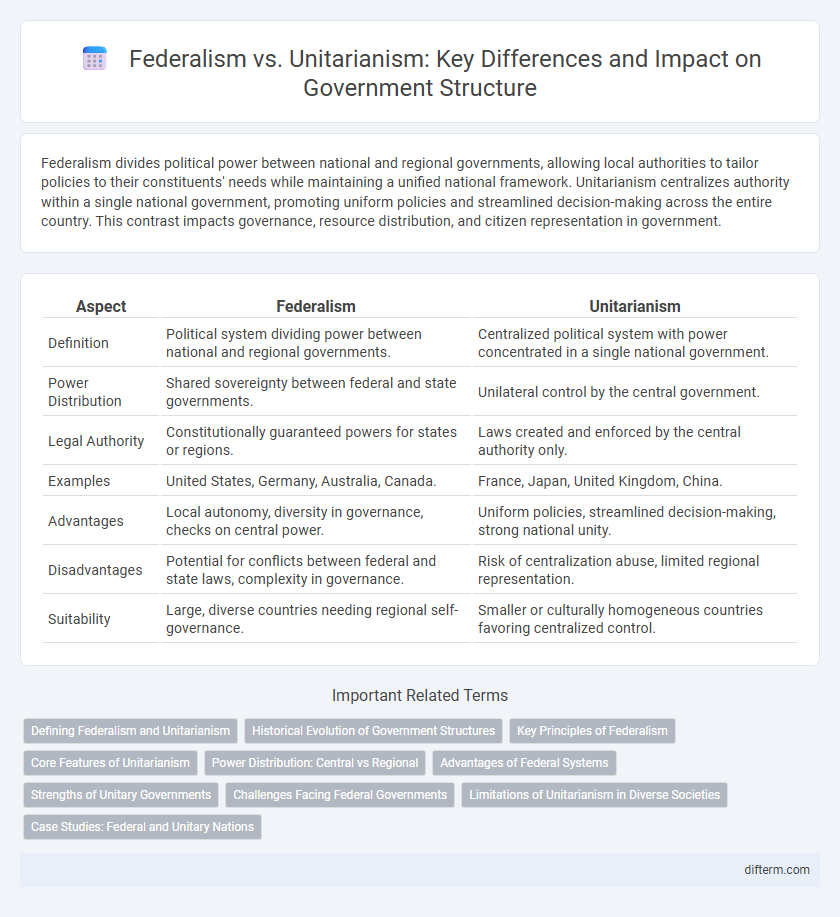Federalism divides political power between national and regional governments, allowing local authorities to tailor policies to their constituents' needs while maintaining a unified national framework. Unitarianism centralizes authority within a single national government, promoting uniform policies and streamlined decision-making across the entire country. This contrast impacts governance, resource distribution, and citizen representation in government.
Table of Comparison
| Aspect | Federalism | Unitarianism |
|---|---|---|
| Definition | Political system dividing power between national and regional governments. | Centralized political system with power concentrated in a single national government. |
| Power Distribution | Shared sovereignty between federal and state governments. | Unilateral control by the central government. |
| Legal Authority | Constitutionally guaranteed powers for states or regions. | Laws created and enforced by the central authority only. |
| Examples | United States, Germany, Australia, Canada. | France, Japan, United Kingdom, China. |
| Advantages | Local autonomy, diversity in governance, checks on central power. | Uniform policies, streamlined decision-making, strong national unity. |
| Disadvantages | Potential for conflicts between federal and state laws, complexity in governance. | Risk of centralization abuse, limited regional representation. |
| Suitability | Large, diverse countries needing regional self-governance. | Smaller or culturally homogeneous countries favoring centralized control. |
Defining Federalism and Unitarianism
Federalism is a system of government where power is constitutionally divided between a central authority and constituent political units, such as states or provinces, allowing regional governments to exercise autonomous legislative and administrative powers. Unitarianism, in contrast, centralizes authority in a single national government, with sub-national units operating under limited or delegated powers that can be altered or revoked by the central government. The distinction between these models lies primarily in the distribution of sovereignty and the degree of political decentralization.
Historical Evolution of Government Structures
Federalism emerged as a response to the challenges of uniting diverse regions under a single government, with early examples found in the United States Constitution of 1787, which balanced power between national and state governments. Unitarianism, conversely, centralized authority in a single national government, often evolving from monarchic or colonial administrations aiming for uniform policy control, as seen in France after the French Revolution. The historical evolution of government structures reveals that federal systems often develop in geographically or culturally diverse nations to accommodate regional autonomy, while unitary states prioritize centralized decision-making for administrative efficiency.
Key Principles of Federalism
Federalism is characterized by the division of powers between national and subnational governments, ensuring autonomy and shared governance. It promotes decentralization, allowing regional units to exercise legislative, executive, and fiscal authority independently within their jurisdictions. Key principles include constitutional supremacy, distribution of powers, and protection of regional interests to maintain balance and prevent centralization.
Core Features of Unitarianism
Unitarianism centralizes political power within a single, national government, eliminating autonomous regional authorities. It emphasizes uniform laws, policies, and administration across all territories to ensure consistency and cohesion. This system facilitates streamlined decision-making and efficient resource allocation under a strong central authority.
Power Distribution: Central vs Regional
Federalism distributes power between central and regional governments, allowing states or provinces to exercise autonomous authority in specific policy areas such as education and law enforcement. Unitarianism centralizes power within a single national government, minimizing regional administrative independence and standardizing policies across the entire country. This contrast in power distribution shapes how public services are managed and how governance responsiveness is achieved at different territorial levels.
Advantages of Federal Systems
Federal systems enhance local governance by allowing regional governments to tailor policies specific to their unique cultural and economic needs. This decentralization promotes political participation and accountability by bringing government closer to the people it serves. Moreover, federalism provides a mechanism for managing diversity and conflicts within a country by balancing power between central and regional authorities.
Strengths of Unitary Governments
Unitary governments offer centralized authority that ensures uniform policies and streamlined administrative processes across the entire nation. This centralization enhances national unity and simplifies decision-making, enabling swift implementation of laws and policies without regional discrepancies. The unitary system also reduces duplication of government agencies, resulting in cost-effective governance and improved resource allocation.
Challenges Facing Federal Governments
Federal governments face significant challenges including coordination difficulties between national and regional authorities, leading to policy inconsistencies and inefficiencies. Balancing autonomy with national unity often results in conflicts over resource allocation, legislative authority, and cultural representation. Managing diverse economic and social priorities across states requires complex negotiation and compromises to maintain overall cohesiveness.
Limitations of Unitarianism in Diverse Societies
Unitarianism often struggles to accommodate the cultural, ethnic, and linguistic diversity found in heterogeneous societies, leading to centralization that may marginalize minority groups. This centralized governance model limits regional autonomy, reducing the ability of local governments to address specific needs and preferences of diverse populations. Such limitations can result in social tensions, decreased political participation, and challenges in achieving equitable resource distribution.
Case Studies: Federal and Unitary Nations
Federalism features decentralized governance where states or provinces hold significant autonomy, exemplified by the United States and Germany, enabling tailored policies and regional representation. Unitarianism concentrates power in a central government, as seen in France and Japan, promoting uniform national policies and streamlined administration. Case studies illustrate that federal systems often handle diverse populations and regional interests more effectively, while unitary systems excel in policy consistency and centralized control.
Federalism vs Unitarianism Infographic

 difterm.com
difterm.com